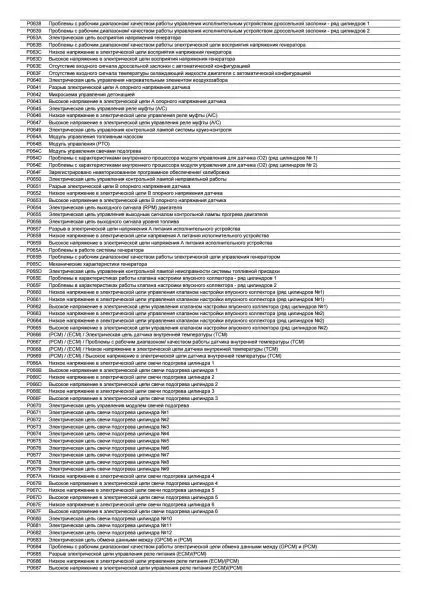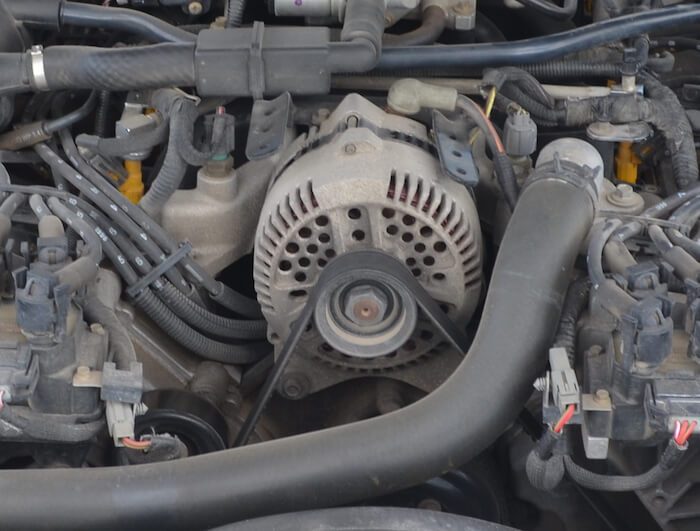
P063C Low voltage generator voltage sensor circuit
Content
- P063C Low voltage generator voltage sensor circuit
- OBD-II DTC Datasheet
- What does this mean?
- What is the severity of this DTC?
- What are some of the symptoms of the code?
- What are some of the common causes for the code?
- What are some steps to troubleshoot the P063C?
- What are the standard ways to fix this code?
- Related DTC discussions
- Need more help with a P063C code?
P063C Low voltage generator voltage sensor circuit
OBD-II DTC Datasheet
Low voltage generator voltage sensor circuit
What does this mean?
This is a generic Diagnostic Trouble Code (DTC) applicable to many OBD-II vehicles (1996 and newer). This may include but is not limited to Jeep, Chrysler, Dodge, Ram, Cummins, Land Rover, Mazda, etc. Despite the general nature, the exact repair steps may vary depending on the model year, make, model and configuration. transmissions.
The P063C OBDII trouble code is related to the alternator voltage measurement circuit. When the powertrain control module (PCM) detects abnormal signals on the alternator voltage measurement circuit, a code P063C will set. Depending on the vehicle and the specific fault, the battery warning light, check engine light, or both will illuminate. The associated codes associated with this circuit are P063A, P063B, P063C, and P063D.
The purpose of the alternator voltage measurement circuit is to monitor alternator and battery voltages while the vehicle is running. The alternator output voltage must be at a level that will compensate for the drain on the battery from electrical components, including the starter motor, lighting, and various other accessories. In addition, the voltage regulator must regulate the output power to provide sufficient voltage to charge the battery.
P063C is set by the PCM when it detects a low voltage condition in the generator (generator) sensing circuit.
Example of an alternator (generator): 
What is the severity of this DTC?
The severity of this code can vary greatly from a simple check engine light or a battery warning light on a car that starts and runs to a car that won't start at all.
What are some of the symptoms of the code?
Symptoms of a P063C trouble code may include:
- Battery warning lamp is on
- The engine will not start
- The engine will crank more slowly than usual.
- Check engine light is on
What are some of the common causes for the code?
Reasons for this P063C code may include:
- Defective generator
- Defective voltage regulator
- Loose or damaged coil belt.
- Defective seat belt pretensioner coil.
- Blown fuse or jumper wire (if applicable)
- Corroded or damaged connector
- Corroded or damaged battery cable
- Faulty or damaged wiring
- Defective PCM
- Defective battery
What are some steps to troubleshoot the P063C?
The first step in troubleshooting any problem is to review the vehicle-specific Technical Service Bulletins (TSBs) by year, model, and powerplant. In some cases, this can save you a lot of time in the long run by pointing you in the right direction.
The second step is a thorough visual inspection to check the associated wiring for obvious defects such as scratches, abrasions, exposed wires, or burn marks. Next, check the connectors and connections for security, corrosion and damage to the contacts. This process should include all electrical connectors and connections to the battery, alternator, PCM, and voltage regulator. Some charging system configurations can be more complex, including relays, fuses and fuses in some cases. The visual inspection should also include the condition of the serpentine belt and belt tensioner. The belt should be taut with some degree of flexibility and the tensioner should be free to move and apply adequate pressure to the serpentine belt. Depending on the vehicle and charging system configuration, a faulty or damaged voltage regulator will require alternator replacement in most cases.
Advanced steps
The additional steps become very vehicle specific and require appropriate advanced equipment to be performed accurately. These procedures require a digital multimeter and vehicle-specific technical reference documents. The ideal tool to use in this situation is the charging system diagnostic tool, if available. Voltage requirements will depend on the specific year and vehicle model.
Voltage test
The battery voltage must be respectively 12 volts and the generator output must be higher to compensate for electrical consumption and charge the battery. Lack of voltage indicates a faulty alternator, voltage regulator, or wiring problem. If the generator output voltage is within the appropriate range, it indicates that the battery needs to be replaced or there is a wiring problem.
If this process detects that a power source or ground is missing, a continuity test may be required to check the integrity of the wiring, alternator, voltage regulator, and other components. Continuity testing should always be performed with power removed from the circuit and normal wiring and connection readings should be 0 ohms unless otherwise specified in the datasheet. Resistance or no continuity indicates faulty wiring that is open or shorted and requires repair or replacement.
What are the standard ways to fix this code?
- Alternator replacement
- Replacing a blown fuse or fuse (if applicable)
- Cleaning connectors from corrosion
- Repair or replacement of wiring
- Repair or replacement of battery cables or terminals
- Replacing the coil-type seat belt tensioner
- Replacing the coil belt
- Battery Replacement
- Flashing or replacing PCM
Common mistakes can include:
- Replacing the alternator, battery, or PCM if the wiring or other component is damaged is a problem.
Hopefully the information in this article has helped point you in the right direction to troubleshoot a generator voltage measurement circuit DTC problem. This article is for informational purposes only and specific technical data and service bulletins for your vehicle should always take priority.
Related DTC discussions
- There are currently no related topics in our forums. Post a new topic on the forum now.
Need more help with a P063C code?
If you still need help with DTC P063C, post a question in the comments below this article.
NOTE. This information is provided for informational purposes only. It is not intended to be used as a repair recommendation and we are not responsible for any action you take on any vehicle. All information on this site is protected by copyright.

